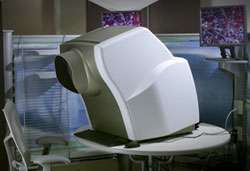IMAX On the Desktop with Kodak Breakthrough Next-Generation 3D Stereo Display

Kodak Monocentric Optics System(TM) Offers Increased Brightness with Mobile Workstation Design; System Available in October, 2004
Eastman Kodak Company today previewed its next-generation Kodak 3D Stereo Display(TM) system, the industry's leading autostereoscopic display, at SIGGRAPH 2004 in Los Angeles. The new system - which is comparable to having an IMAX(R) movie theater in a desktop display - incorporates technical breakthroughs that provide an ideal display for intensive visualization tasks, such as oil and gas exploration, molecular and chemical modeling, computer-aided design, entertainment and gaming, and many other applications. The enhanced version of the display will be available for customers in October. Kodak will take orders for the new system at SIGGRAPH.
The new version of the Kodak 3D Stereo Display incorporates the Kodak Monocentric Optics System(TM), a recent innovation from Kodak that enables concentrated brightness, as well as an ergonomic design, and a more compact, mobile footprint. Unlike many other stereoscopic display systems, the Kodak 3D Stereo Display does not require a dim lighting environment, and can be used with normal office lighting. T he new system, which incorporates an innovative adjustable design in a self-contained mobile unit, will make its public debut at the iGames Expo in New York City, September 10-12, at the Hammerstein Ballroom in Manhattan Center.
"The market for 3D displays will increase significantly in both the industrial and consumer sectors as microprocessors improve throughput, and more graphics-intensive applications gain wider acceptance in daily use," said Tracy Floyd, analyst with IDC. "The Kodak 3D Stereo Display is a breakthrough in the industry, demonstrating that direct-view displays can incorporate cost-effective, true stereo imaging in full resolution, which has been a holy grail for the past 30 years."
The Kodak 3D Stereo Display offers customers an easy, comfortable viewing system for complex images, such as molecular models, geospatial imaging, or tomography, in rich stereo 3D with normal office lighting and with greater ease on their eyes than ever before. Kodak's unique design creates a quick easy method of locking in on a "sweet spot" so that viewers can spend more time viewing critical data without suffering eyestrain or loss of image resolution.
"Today, 3D imagery is predominant in an increasing number of data visualization applications, and the Kodak 3D Stereo Display enables true stereo imaging for everyday use by eliminating barriers to comfortable viewing," said Lawrence Henderson, vice president and director, new business ventures, Eastman Kodak Company. "The latest design of our system integrates another revolutionary approach to stereoscopic imaging, the Kodak Monocentric Optics System, which delivers a more immersive experience for the desktop imaging professional."
The Kodak 3D Stereo Display is currently using the Nvidia Quadro FX 1000 AGP card, with a resolution of 1280 x 1024 pixels, a field of view that measures 45 degrees by 36 degrees, and 40 mm viewing pupils that give the viewer the feeling of floating in a movie theater about 1.5 screen heights away from the screen. The underlying technology can be flexibly configured to suit different resolutions, whether XGA or SXGA, or size requirements. Another key differentiator is the plug-and-play nature of the system, which is compatible with any industry-standard video or still image source, and operates with PC, Mac, or SGI platforms. The Kodak 3D Stereo Display delivers superior output using any off-the-shelf video card, such as NVIDIA or any Micrososft DirectX-, Direct 3D or Open GL-compatible cards. The system integrates Kodak's patented lens technology with mirrors, two LCD panels, and specialized components into a single piece, which results in an SXGA resolution and concentrated brightness that is five times greater than the previous system.
How it Works
The user sits in front of a system that creates a virtual image of two high-resolution LCD displays, one for each eye. The user looks into two "floating balls of light" that provide each eye a view of a magnified image of one of the two displays. The combination of the wide field of view, the virtual image, and the absence of imaging artifacts eliminates many of the sources of eyestrain that are present in other stereoscopic systems.
Kodak is a trademark of Eastman Kodak Company.
Source: KODAK

















